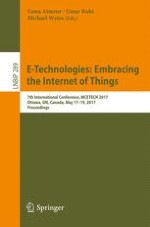This book constitutes the refereed proceedings of the 7th International Conference on E-Technologies, MCETECH 2017, held in Ottawa, ON, Canada, in May 2017.
This year’s conference drew special attention to the ever-increasing role of the Internet of Things (IoT); and the contributions span a variety of application domains such as e-Commerce, e-Health, e-Learning, and e-Justice, comprising research from models and architectures, methodology proposals, prototype implementations, and empirical validation of theoretical models.
The 19 papers presented were carefully reviewed and selected from 48 submissions. They were organized in topical sections named: pervasive computing and smart applications; security, privacy and trust; process modeling and adaptation; data analytics and machine learning; and e-health and e-commerce.
